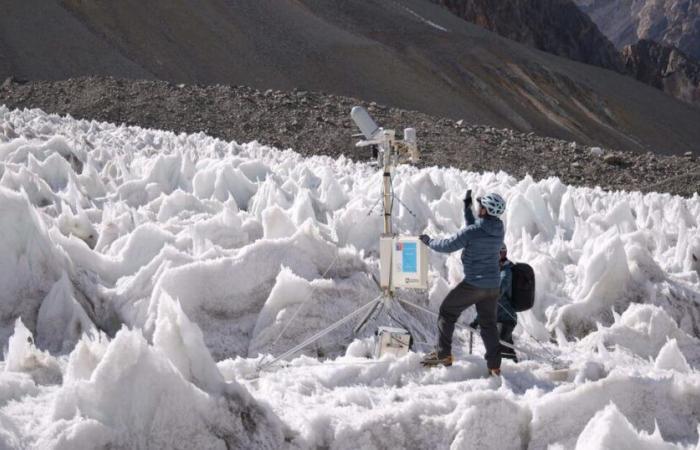In the Maipo river basin, just 60 kilometers from Santiago, The northern Echaurren glacier agonizes in silence. Since 1975 it has lost more than 30% of its mass, but few know it. According to measurements made for almost five decades, this glacier has lost an equivalent layer of 33 meters of accumulated water. Its setback is no longer just an environmental warning: it is a direct signal to the city that depends on its thaw to drink, water and live.
Andrés Rivera, academic from the University of Chile And one of the main voices of glaciology in the country warns that the water contribution peak of the glaciers of the central zone was already behind. Water contributions, especially in summer – when more are needed for consumption and irrigation – will continue to decrease. This situation, he points out, will increasingly stress the Santiago drinking water supply system, forcing adaptation measures such as reducing consumption, loss control and the highest recycling of sewage.
The same goes for more than 2,000 kilometers south, where the Steffen glacier —A giant nestled in deep Patagonia – begins to fracture, feeding unstable lagoons that could be emptied suddenly. This is what scientists call Glacier Outburst Floods (Glofs), a phenomenon with destructive potential that has already happened before. In 2021, the Laguna Tépanos, fueled by the Steffen glacier, was suddenly emptied.
More ice bodies, less volume
The ice goes back. And he doesn’t do it alone. With it, water security, the stability of ecosystems, biodiversity that depends on those microclimates, and the culture of water that still survives in some territories is led. According to the last public glacier inventorycarried out by the General Directorate of Aguas (DGA) and published last January, Chile houses more than 26 thousand ice bodieswhich makes it the country with the highest glacier surface in South America. Although the amount of glaciers has increased with respect to the previous measurement – product of the fragmentation of large ice masses in minor bodies – the total ice area and the equivalent volume in water have decreased significantly in recent decades.
In the central zone, some glaciers have reduced their area by more than 50%. And although in Patagonia the volume remains greater, there has also been documented an acceleration of melting. In the southern Austral region, the temperature increase has reached 1.5 ° C, which contributes to the rapid loss of eternal ice, says the researcher José Luis Iriarte, from the U. Austral of Chile.
This accelerated fusion not only threatens the availability of fresh water, but is also altering marine chemistry, pH, oxygen levels and the nutrient cycle in patagonian fjords and channels, affecting the foundations of coastal ecosystems. “We still know little about how fresh water entry into coastal systems, product of glacial fusion, will affect marine productivity and the nutrient cycle,” warns José Luis Iriarte.
The researcher emphasizes that this phenomenon cannot be seen only as an environmental problem limited to the thaw. “We need to understand these processes as a key piece in the functioning of the climate and marine system of southern Chile,” he says.
It’s not just weather
What is causing this setback? And although the answer seems obvious – climate change – the regional panorama warns that it is not a distant or abstract threat. In 2024, Venezuela lost its last glacier: the Humboldt, a symbol of an era that extinguishes. The rabbit glacier in Colombia and the South Martial in Argentina also disappeared. These cases show that disappearance is not a future possibility: it is a reality that already occurs in the region.
But there is not only one factor. To the global temperature increase tendency is added a mega-sequía of more than 14 years, the alteration of the rainfall regime, and phenomena such as the child, which intensify seasonal losses. In addition, human activity – like mining in areas close to glaciers or development without regulation of tourism in high mountain – adds pressure on these fragile bodies.
Despite this, Chile does not yet have a glacier protection law. The national glacier strategy, in force since 2009, drew a road map that has allowed increasing monitoring of glaciers and the high mountain basins. But, it is not enough. Why, then, do we continue without a robust policy to protect one of the country’s most strategic ecosystems?
Part of the answer can be in the fragmentation of the system: the DGA monitors, but with limited resources; Scientists investigate, but many times without state continuity or support; Regional universities, such as the UMAG or the Austral, lead research in extreme places, but their results rarely translate into political decisions. José Luis Iriarte He warns that there is still great uncertainty about how these changes will affect biological productivity and CO₂ exchange processes in the interior seas, a field where science advances but without the sustained support that these investigations of long breath require.
Andrés Rivera He acknowledges that in recent decades there have been significant advances in glaciers monitoring, specialist formation and the application of homologable methodologies. “This, however, does not yet meet the growing information needs about what happens to many glaciers in the country, and more importantly, which will happen to them in the future,” he warns.
Rivera adds that the lack of adequate financing and the absence of continuity in research projects limit the country’s ability to anticipate the coming scenarios. For him, “every glacier that disappears is an alarm signal.”
An opportunity
This 2025 was declared by the United Nations as the International Year of Glaciers Preservationan initiative that seeks to make visible the accelerated setback of these ice masses and promote concrete actions for monitoring and protection. This scenario offers Chile a unique opportunity to assume leadership on the subject. Not only because it concentrates a vital portion of the South American glaciers, but because it faces one of the most serious water crises on the continent. What will we do while the ice disappears?
And the glaciers that are not seen?
While attention usually concentrates on the recoil of the white and visible glaciers of the center and south of the country, in the north there is another less known but equally strategic reality: that of the rock glaciers.
Hidden under debris and sediments, these glaciers hide ice reserves in the highest areas of the mountain range, where rainfall is minimal and snow fails to accumulate permanently. “These glaciers may seem just a hillside of loose rocks, but under that surface ice is preserved that allows them to move slowly, just like traditional white glaciers,” he explains Christian Herrera, academic and director of the Technological Research Center of Water and Sustainability in the Desert, of the Catholic of the North.
Rocky glaciers represent 13.74% of ice bodies in the country. However, its surface is reduced: the 3,598 identified bodies cover only 2.3% of the national glacier coverage. Unlike the great Patagonian ice masses, rocky glaciers do not dazzle because of their size, but fulfill an essential function: to release water gradually in times of drought, contributing to the water supply of arid basins.
“These glaciers feed different basins from the north, as in the Huasco Valley, in the Atacama region. They are strategic reservoirs, although often invisible to public and political look,” says Herrera. Its detection is complex: the layer of rubble that covers them forces to resort to thermal satellite images to recognize their limits.
Amid the accelerated recoil of glaciers nationwide, these hidden reservoirs remember that the water crisis is also free, silent, in the desert mountains.






